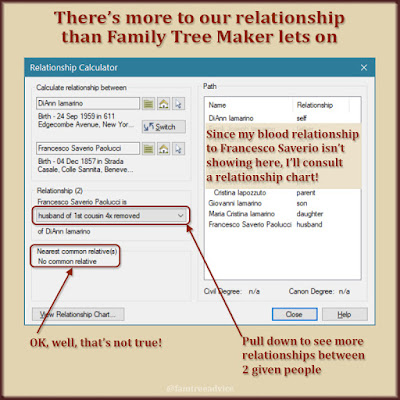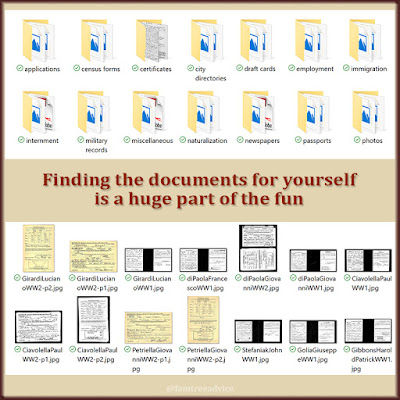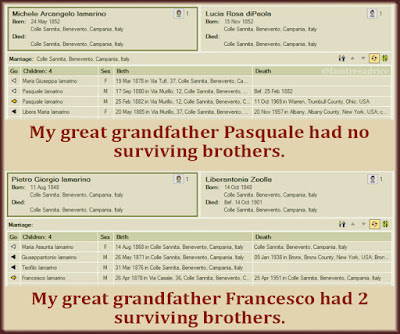My intertwined, overlapping, twisted family tree just got a new tool.
It seems that 98% of the people with my maiden name have roots in one town in Southern Italy. Colle Sannita is the birthplace of the Iamarino name. (See Where Did Grandpa Come From? to learn how important your ancestor's hometown is.)
So when I noticed Maria Cristina Iamarino, born in 1863, married a man named Paolucci, I had to dig deeper.
Many of my DNA match's relationships connect to the name Paolucci. It's a prevalent name in Colle Sannita. Most of these relationships connect to my great aunt's in-laws. My Great Aunt Assunta Iamarino married Donato Paolucci, and his family is enormous. That time I connected my dad to his best friend it was through that same Paolucci family.
Maria Cristina Iamarino is my 1st cousin 4 times removed. Her grandparents are my 4th great grandparents.
Her husband is Francesco Saverio Paolucci. In Family Tree Maker, I see that his great grandparents are my 5th great grandparents. They are Pietro and Carmina.
As a direct descendant of my 5th great grandparents, he does have a blood relationship to me. I thought I'd find it by using Family Tree Maker's Relationship Calculator.
 |
| The Relationship Calculator in Family Tree Maker isn't taking everything into consideration. |
While viewing Francesco Saverio Paolucci in my tree, I can click Tools / Relationship Calculator. In the Relationship section there is a pull-down menu listing our relationships:
- husband of 1st cousin 4x removed
- father-in-law of 2nd great aunt
That's no good. Neither one is a blood relationship, and he's the great grandchild of my ancestors. I know our common ancestors are in my paternal grandmother's line because I use color-coding.
 |
| A combination of tools helped me find our hidden relationship. |
Using the Relationship Calculator I can compare Lucy Iamarino (my grandmother) to:
- Pietro Piacquadio. He is her 3rd great grandfather. So far, so good. Now to his son.
- Donato Piacquadio. He is Lucy's 3rd great uncle because he's the brother of her 2nd great grandmother. Now to his daughter.
- Angela Piacquadio. She is Lucy's 1st cousin 3x removed. Next is her son.
- Francesco Saverio Paolucci. That's where the Relationship Calculator fails. It shows only in-law relationships and finds no common relative. But I can see their common ancestors!
What I need is a chart that can help me put a name to distant relationships. I found one, and using it is a real mind-bender partly because of its diamond shape. Using the chart I found that:
- Lucy and Francesco Saverio are 2nd cousins 2x removed.
- Francesco Saverio and I are 2nd cousins 4x removed. Of course that makes sense because I'm a 2-generation descendant of Lucy, his 2nd cousin 2x removed. My dad has to be (and is, per the chart) Francesco Saverio's 2nd cousin 3x removed.
Here's another challenge with this family that I'd like to solve. If I can figure this out, I can stop missing out on distant cousin relationships.
Francesco Saverio Paolucci (my 2nd cousin 4x removed) and his wife Maria Cristina Iamarino (my 1st cousin 4x removed) had 2 sons who married sisters from my grandfather's family. (If you're going insane reading that, add this: My paternal grandparents are 3rd cousins, both named Iamarino.)
The 2 sons (Giovanni and Antonio) are my 3rd cousins 3x removed. Their wives (Carmela and Maria Maddalena) are my 2nd great aunts.
Since the 2 men are on my paternal grandmother's side, and the 2 women are on my paternal grandfather's side, I should have multiple relationships to their kids. I happened to meet one of the sons of Antonio and Carmela—as well as his son—in their home in Colle Sannita in 2005. Antonio and Carmela's son is my 1st cousin 2x removed, but let's see what else he is.
The Family Tree Maker Relationship Calculator won't even try to call him anything but my 1st cousin 2x removed. But the chart I found doesn't give up. As the son of Antonio, he is also my 4th cousin 2x removed. And his son, who is my 2nd cousin 1x removed on his mother's side, is my 5th cousin 1x removed on his father's side.
The chart is on Wikimedia. Zoom in on it before you lose your mind.
I also found a calculator that let's you skip the running-2-fingers-along-the-chart step. To use this calculator, choose a common ancestor for you and the person you want to figure out. I'll use the calculator to figure out my relationship to the man I met in Italy who is my 2nd cousin 1x removed on his mother's side. We're roughly the same age.
In the calculator I enter that I'm the 5th great grandchild of the common ancestor (Pietro/Carmina). The man I met is the 4th great grandchild of the same ancestor. The calculator says we are 5th cousins 1x removed. It gives me the option of seeing a relationship chart. While I appreciate the visual, it took me 3 tries to get the right chart. So I made my own version in Excel. You can download my chart for yourself. If you want to make it fit on a piece of paper, you'll have to give up some generations.
 |
| I made an easier-to-use chart to figure out distant relationships. |
I'm not sure this will solve my problem with DNA matches who only map to an in-law. But if there's a common ancestor hiding in my tree, all secrets will be revealed.
What got me started on this topic was a new discovery. I've been talking about here Francesco Saverio Paolucci. Well, all I knew about his mother was her name was Angela Piacquadio. I hadn't found her parents yet. When I did find them, Angela went from one of those long in-law relationships to my 1st cousin 5x removed.
That's how I learned Francesco Saverio Paolucci was the great grandson of my 5th great grandparents.
That's how all these cascading relationships changed.
Take a look at your family tree. Who is missing parents because you haven't looked for them yet? Are their parents are already waiting there in your family tree?









